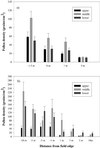Corn pollen deposition on milkweeds in and near cornfields
- PMID: 11559840
- PMCID: PMC59743
- DOI: 10.1073/pnas.211287498
Corn pollen deposition on milkweeds in and near cornfields
Abstract
The density of corn pollen on leaves of milkweed plants inside and outside of cornfields was measured in several studies from different localities. The purpose was to obtain a representative picture of naturally occurring pollen densities to provide a perspective for laboratory and field studies of monarch larvae feeding on milkweed leaves with Bt corn pollen. Pollen density was highest (average 170.6 grains per cm(2)) inside the cornfield and was progressively lower from the field edge outward, falling to 14.2 grains per cm(2) at 2 m. Inside the cornfield, and for each distance from the field edge, a frequency distribution is presented showing the proportion of leaf samples with different pollen densities. Inside cornfields, 95% of leaf samples had pollen densities below 600 grains per cm(2) and the highest pollen density observed was 1400 grains per cm(2), which occurred in a study with a rainless anthesis period. All other studies had rainfall events during the anthesis period. A single rain event can remove 54-86% of the pollen on leaves. Leaves on the upper portion of milkweed plants, where young monarch larvae tend to feed, had only 30-50% of the pollen density levels of middle leaves.
Figures

Comment in
-
Bt or not Bt: is that the question?Proc Natl Acad Sci U S A. 2001 Oct 23;98(22):12328-30. doi: 10.1073/pnas.241503398. Proc Natl Acad Sci U S A. 2001. PMID: 11675483 Free PMC article. No abstract available.
References
-
- Losey J E, Rayor L S, Carter M E. Nature (London) 1999;399:214. - PubMed
-
- Jesse L C H, Obrycki J J. Oecologia. 2000;125:241–248. - PubMed
-
- Raynor G S, Ogden E C, Hayes J V. Agron J. 1972;64:420–427.
-
- Louette D. In: Gene Flow among Maize Landraces, Improved Maize Varieties and Teosinte: Implications for Transgenic Maize. Serratos J A, Willcox M C, Castillo F, editors. Mexico, D.F.: International Maize and Wheat Improvement Center; 1997. pp. 56–66.
Publication types
MeSH terms
Substances
LinkOut - more resources
Full Text Sources

